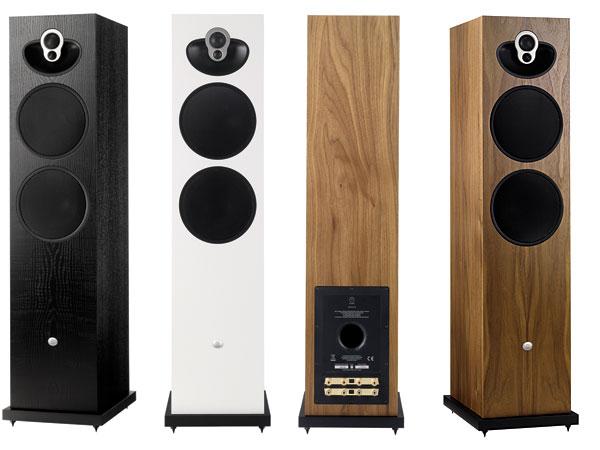| Columns Retired Columns & Blogs |
These must be amazing speakers if they make Don's guitar work sound "harmonically right".

Design The Majik 140 incorporates Linn's 2K tweeter-supertweeter array, derived from the 3K and 4K arrays used in Linn's more expensive models. The 2K comprises a 1.17" (30mm) tweeter with a soft dome of polyurethane elastomer covering the 1.5–6kHz range, and a 0.5" fabric-dome supertweeter for frequencies above 6kHz. Below this are two 6.5"-cone units that look identical but are not. The upper unit, which covers the region below 1.6kHz, uses a doped-paper cone and operates in a sealed enclosure. The lower unit is a dedicated bass driver with a glass-fiber-and-composite cone that operates in its own enclosure, vented to the rear, and reinforces the output of the midrange unit below 200Hz. The speakers are supplied with a pair of foam bungs which enable the user to plug the rear port for setups where the speakers are placed flush against a rear wall.
The Majik 140 is fitted with metal spike feet that are easily adjustable for precise leveling. Also available is an optional stand ($580/pair, not supplied for review) made from a single billet of aluminum, which is nearly five times heavier than the standard wooden plinth. Phillip Budd, Linn's senior acoustic engineer, claims that this heavy plinth improves the Majik 140's performance.
The Majik 140 is available in standard finishes of Black Ash, Rosenut, Walnut, Cherry, Oak, and White; high-gloss custom finishes are available for another $950/pair. My Walnut samples were attractive, but I have a soft spot for the elegant Cherry of my Majik 109s.
 Sound
Sound
The Majik 140 can be single-, bi-, tri-, or quadwired, and single-, bi-, tri-, or quad-amped. I used a single amplifier and a triwire set of Acarian Systems Black Orpheus speaker cables. As I tested the speakers with my typical setup with a 48" distance between the rear of the speaker cabinet and the back wall, I didn't audition the speakers with the foam bungs.
The Majik 140's midrange reproduction was beyond reproach: the sound of every instrument with significant content in that frequency region was rendered without colorations and with extraordinary detail. I can't think of a purer midrange instrument than the clarinet, and the 140 reproduced virtuoso Anat Cohen's instrument, as recorded on her Poetica (CD, Anzic 1301), with all the subtle inflections of a captivating live performance.
Every vocal recording that I played fared well with the Majik 140's midrange presentation. Madeline Peyroux's eclectic range of material on her Dreamland (CD, Atlantic 82946-2) was uniformly presented with sweet, silky, rich verisimilitude. However, I noticed something unusual when I cued up tracks from Tom Waits's Real Gone (CD, Anti- 86678-2). In this recording, subtle low-level distortion has been intentionally added to Waits's voice to give it a certain texture. Through the Majik 140, this distortion wasn't subtle at all; the speaker was so revealing that the distortion seemed highlighted and rather disjointed when juxtaposed against the pristine rendition of the other instruments on the recording.
The Majik 140's reproduction of jazz guitar was also captivating. In The Poll Winners: Barney Kessel with Ray Brown and Shelly Manne (CD, JVC XR-0019-2), Kessel's archtop axe had a crystalline, bell-like quality in the upper register, and the rich, woody warmth of his lower-end chording made it obvious that he was playing through a vintage tube guitar amp.
As I'd expected, the 2K tweeter-supertweeter array that the Majik 140 shares with the Majik 109 rendered high frequencies with the same detailed, extended, and natural clarity I remembered from my time with those bookshelf speakers. I sat there analyzing Liam Sillery's trumpet phrasing on his Outskirts (CD, OA2 22050): His melodic line in "Prana" was brassy and burnished but still light and airy, with all of his unique low-level dynamic articulation clear. The upper harmonic extensions of all of Sillery's notes were reproduced with definition, air, and just the right amount of metallic bite.
The Majik 140 also mated well with well-recorded violins. Jenny Scheinman's violin in "The Frog Threw His Head Back and Laughed," from her 12 Songs (CD, Cryptogramophone CG125), sounded extended and appropriately sharp in the upper register, but also had a sweet, holographic, voluptuous quality throughout its range. Further mining my collection of string recordings, I dug into Evan Ziporyn's Typical Music (CD, New Albion NA 128). The Linn's reproduction of this piano trio grabbed my attention as I studied the interplay of members of the Arden Trio: Suzanne Ornstein's searing, silky violin, and Clay Ruede's woody, rosiny cello.
The Majik 140's high-frequency resolution combined with its superb reproduction of transients to make it a breathtaking showcase for percussion recordings. In Second Interlude, from Philipp Vandré's recording of John Cage's Sonatas and Interludes for Prepared Piano (CD, Mode 50), the strings are modified to turn the piano into an 88-key percussion instrument. Every thwack, brnggg, and sfffzzt in this performance seemed to pop out of thin air, each sound reproduced within its unique dynamic envelope and a long, natural decay.

These must be amazing speakers if they make Don's guitar work sound "harmonically right".

Lately have not been a fan of Linn products; overpriced and better sounding gear out there. However I do miss the 80's and 90's when they introduced the Klout, Kairn, Kremlin, Karik, Numerik, Kelidih and Kabers some of these products I used to own. It is good to see a speaker that follows in that tradition.

I would be very interested to see the effect of using Linn's Exakt system (Exaktbox-I is designed for the 140)
as this would completely bypass the crossovers in the speakers and it would be very interesting to read a professional opinion of the change - I can find not a single review of this anywhere in the world!